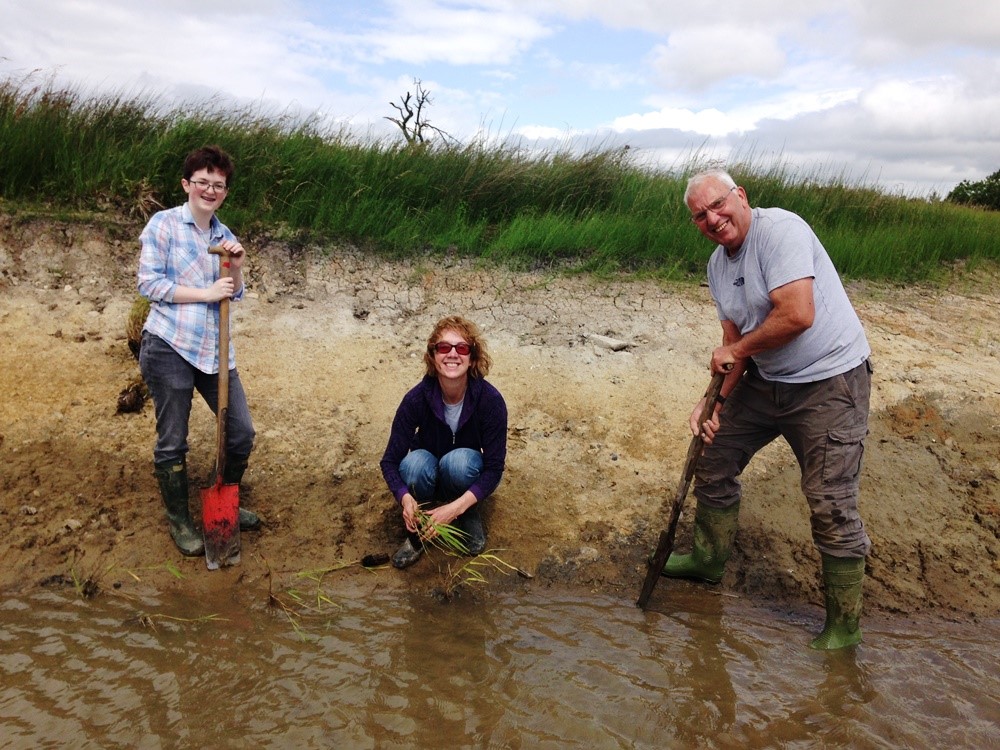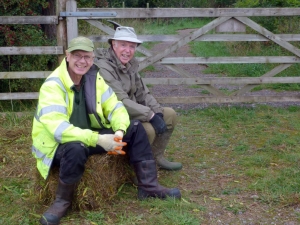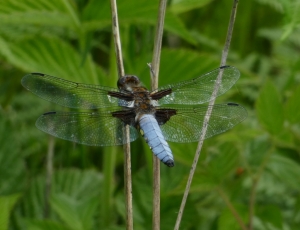Blog Archive (30) Posts Made in January 2017
Wet Weather and Wildlife
Tuesday, January 31st 2017
A team of intrepid volunteers turned out to help with practical site work today despite the grey and particularly wet weather – thank you!
As regular readers of this blog will know, this year’s coppice block is in progress. However, we thought that if we attempted continuation of this today we would end up with a quagmire and some very muddy people! So, instead we tackled a job that’s been on the list for a while and involved working in a sheltered part of the reserve: Re-doing the woodchip path to the green route down near Risedale Beck.



The Dales School helped too – thank you.



The volunteer team were re-fuelled mid-morning by Ann’s delicious flapjacks!

Today was also a day for wildlife sightings…
On the drive into the reserve I spotted this mouse:

Worms were plentiful in the soft earth of the old path:

Birds flocked to the newly-filled-by-Bob-and-Ann feeders:

And caught on camera was this ringed redpoll in the rain!

Spring Like
Monday, January 30th 2017
The weather today was noticeably warmer than the previous week, a few flies buzzed around and the honey bees in the field centre popped in and out for the mid part of the day…. very spring like!
The first thing I did was to have a walk along the Green Route to do a general inspection of the reserve.
I found this unusual morph of a Mottled Umber moth (left), in the more usual Mottled Umber morph the markings are more distinct (right).
In the afternoon we continued clearing the Sedge Warbler patch ready for the coming season. Silver birch and willow had started to encroach this area and needed to be removed.
The Year Is Moving On
Sunday, January 29th 2017
Stacey has reached about half way through her time down at Signy and her chicks are growing up. This is a Chinstrap penguin, which is getting quite big. She says they are comical and cute and I must agree with her. She has named the photograph Chinnie and I think it suits him (or her) well.

I received this information from Stacey. 'The photo below is of the Adelie Penguins. If you look at them closely you'll see many of them have lost lots of the fluffy grey down, and the white and blue/grey feathers are showing underneath. They should start fledging this week. I can't believe its got to fledging time already! I must get over to Gourlay to count my chicks. At this time of year I have to go over every couple of days to count the Adelie chicks in a certain few colonies- once they start to decrease in number I know they've started fledging.'

Down south the days are shortening and the chicks are fledging. Here our days are lengthening and although the reserve is still in its winter colours of grey, brown and black there are signs that spring is approaching. No flowers yet other than Gorse and Daisy, but the leaves of two Cuckoo Pint were spotted yesterday. Not in their usual place.

A flower that grows abundantly through Foxglove is Greater Stitchwort and its leaves are showing through the leaf litter.

Some moths are on the wing for several months while others only appear for a short time. This Pale Brindled Beauty had taken up residence by the door on the front veranda. Its flight season is from January through to March. The larval food plants include Hawthorn, Blackthorn, Apple, Downy and Silver Birch, Alder, Hazel and Ash.

A Busy Day
Saturday, January 28th 2017
Wet, gloomy, dark but less cold this morning as Glennis sat down with pen and paper to record the birds in the back garden, for the RSPB Big Garden Bird Watch. Birds were numerous, feeding on all the feeders and on the ground. There were 38 Redpolls at one point. After the last two weeks when we could count up to 17 Brambling, only one appeared today. We wondered if the slightly milder weather had encouraged them to begin to move north. There were two Robins who were not fighting for territory, could they be a pair?
Add the kitchen window to the weather conditions and the photo taken is not of the best!

Mid afternoon saw some of the bird ringers setting up the reed bed net to catch the Reed Buntings as they came in to roost. Only two were caught, one new, one retrap.
Brian and Peter carried out some of the weekend jobs, which included checking the water pipes and mink rafts as well as stocking up the Water Vole platforms with apples. Jenny, Ann, Bob and friends checked the ponies, who were still munching their way through the far moor.
Thank you very much to everyone who helped today.
With overnight rain there were water droplets everywhere and the opportunity to be a little artistic.

Twigs galore magnified in this one.

The male Holly flowers are in bud. I could just leave that statement so it looks impressive being able to identify male Holly flowers when in bud, but I won't, this tree is a male as it does not have berries.

Blackthorn flowers first along Risedale Beck and the tree is showing its flower buds.

Some weeks ago it was suggested that the writer of the weekend blogs was a little intoxicated, well there is a possibility that she may be so again. Read on. The Moles have been busy on the middle moor, two lovely straight lines.

This is the culprit - a Mole!

Make Do and Mend !
Friday, January 27th 2017
The past couple of days the outdoor temperature has struggled to get above freezing, the wind chill making it considerably colder, but still our volunteers came in well wrapped up ready for the various tasks we had in store for the day. Jenny, below, filled the hoppers.
John and Stuart fixed the trailer punctures
While Keith repaired owl boxes….
... from the previous day jaunt replacing the damaged and lost owl boxes around the reserve. It is important that all the owl/kestral boxes are in good repair for the coming season as the last thing we want is a box falling from a tree with juvenile birds occupying them!
.jpg)
Please note that we run an Adopt-a-Box scheme which enables us to purchase materials to ensure these boxes are in good order, it is a great gift for someone if not for yourself! Follow this link for details https://www.foxglovecovert.org.uk/support-us/adopt-a-box-scheme/
Jonathan and Jackie repaired the wooden steps near the Hazel Avenue…..
as well as replacing some lost and damaged small bird nesting boxes.
Today the bitter chill continued, ....
....again coating flora and fauna
Numerous Redpolls fed on the nyger feeders and the spill below. The large numbers visiting the reserve encouraged us to put a few mist nets up in the garden to ring this hungry bunch before releasing them so they could continue feeding on the seed we put out for them.
Thank you to all the volunteers for braving the elements.
An Evening Exploration
Wednesday, January 25th 2017
As usual on a Wednesday we started the day by checking the moth trap we had put out last night. Finds today included this early moth, Theria primaria, which becomes active after dusk.
This one, like all the other early moths we catch is a male, as like many moths that are active in the winter months the females are almost wingless and they don’t stray far from their food plant. We thought it would be interesting to see one, so earlier in the week we ventured out in the evening armed with head-torches!
We found this male early moth in the wild (and on a food plant, in this case, hawthorn).
Going out after dark with a torch seemed to be a particularly good way to spot spiders!
We also found a variety of other creepy crawlies. Examples of our finds include:
Rove beetle
Harvestman
Small snail
Capsid
And these…We’re not quite sure what they/it are/is… Maybe lacewing eggs…?
The beauty of dew was very noticeable in the torchlight. We admired the way these droplets were lined up on a blade of grass.
However, sadly for us, we did not find any female early moths, but here is a photo of one spotted at Foxglove back in 2014!

Toasting a Successful Day!
Tuesday, January 24th 2017
I arrived this morning at the same time as one of our volunteers, John. He had recently spotted an unusual bird at Easby Abbey and had brought us some photos. We agree it’s an unusual bird…
We think it’s a leucistic robin! Leucism is a plumage abnormality caused by a lack of melanin pigment. If you want to find out more about plumage abnormalities or if you have seen a bird with unusual plumage and would like to report it please click here for information on the BTO’s Abnormal Plumage Survey.
The main task of the day was continuing the coppice block. The section we worked on today was a bit of a jungle in places – For this photo I’d asked John and Eddie to give me a wave!

Some hard work with a great team-spirit and lots of progress made:

.jpg)

Elsewhere Bryan filled our bird feeders which the birds have been emptying quickly in this cold weather, Brian re-staked some trees and gave some TLC to a bird box and Eddie and John built us a new stretch of woodchip path where previously there had only been mud.
A mid-morning treat was toast-your-own marshmallows for those who wanted them. A nostalgic treat for some and a new experience for others!


Thank you to all who helped today!
Smiles, Spider Webs and a Shieldbug
Monday, January 23rd 2017
It wasn’t just ringing that we were busy with at the weekend: On Saturday we also had a party of children in exploring tracks and signs on the reserve with Roger. They had a great time – the smiles say it all!

Today was a quieter, planning and catching up day: working on a few things for our Foxglove 25 weekend on the 15th and 16th of July (save the dates!) and getting an area around one of our fire sites tidied up.

It was a cold, crisp morning and coming in for a walk Elizabeth (with the unfulfilled-today hope of finding the first primrose in flower) spotted spider webs strung with ice crystals…


…and this shield bug.

We think it’s a common green shield bug, Palomena prasina (please let us know if you know otherwise!). In the spring and summer adults of this species are bright green, but they become a darker bronze-brown, like this one, in the autumn prior to winter hibernation.
A Round Up
Sunday, January 22nd 2017
Checking on the ponies I thought I had an ideal shot of them, both more or less looking my way. Then I downloaded it and found a large metal feeder between them. Not one for the 2018 calendar!

Whilst walking around, it was observed that some catkins were open and ready to disperse their pollen.

This tree is near to the Stone Pile and every year it is the first to show its open catkins. We looked all over the tree but could find no female flowers and thought what a waste of pollen and that the tree 'was out of step'. However there was no need to worry, as about a week later there were plenty of female flowers on show.

The back garden at Foxglove has been really busy with birds. Chaffinches, Goldfinches. Redpolls, Great, Blue and Coal Tits, Robins, Blackbirds and Great Spotted Woodpeckers to name some feeding from the feeders and on the ground. Looking out of the kitchen window it was a surprise to see a Brambling on the feeder. Usually these birds feed on the ground under the main feeders and are rarely seen in this part of the garden.

Perfect conditions saw the bird ringers back at the Starling roost. Are you sitting comfortably? Then we'll begin - ringing!

It was interesting to see that the majority of the birds were females, hatched last year. Many of them were developing the pink on their beaks, which was missing three weeks ago.

Thank you to everyone who helped as it may have been good ringing conditions but it was not too good for humans!
Back by Popular Demand: Get Your Cameras Out!
Saturday, January 21st 2017
In 2016 we ran a photo competition to find beautiful pictures for the 2017 Foxglove Covert Calendar. The response we had was brilliant, with over 100 photos for our judge to choose from and the finished calendar quickly sold out! So, back by popular demand: A Photo Competition! This time to find pictures for the 2018 Foxglove Covert Calendar!
The photos should be taken on the reserve at Foxglove Covert LNR or on the surrounding moorland. We will be choosing 12 landscape format photographs to be used in the calendar, illustrating the season and/or showing some wildlife. We will also be looking for a suitable portrait format photo for the front cover.
The calendar needs pictures from different seasons – a great excuse to visit Foxglove regularly to capture the changing moods and seasons on camera! Get out soon to catch the wonders of winter, but don’t risk losing or forgetting about that brilliant picture – you can start sending them in anytime from now!
In addition to having your photos in the calendar, there will be a prize for the photos which the judges consider to be Best Adult photo and Best Child photo (16 years and under).
Please submit your photos as prints (minimum 6” x 4”) in an envelope marked “Calendar Competition” to the Foxglove Office (in the Field Centre), by post to Foxglove Covert LNR, Wathgill Camp, Downholme, Richmond, North Yorkshire, DL11 6AH or email to foxglovelnr@btinternet.com with a file size of between 1MB and 4MB and the subject line ‘Calendar Competition’ by midnight on FRIDAY 15TH SEPTEMBER 2017.
The competition is open to everyone. Please include a title and location for your photo(s), your name, contact details including a phone number and your age if 16 years or under. You can enter as many photos as you like as long as you are happy for your photo(s) to be used in the Foxglove Covert LNR Calendar and any associated publicity. All photographers will be credited. For full terms and conditions email foxglovelnr@btinternet.com.
The Water Vole and Wall butterflies, shown below, were chosen for the 2017 calendar.


Worms and Vibrations
Friday, January 20th 2017
One of the jobs today was filling potholes in the access track. At this time of year they seem to develop especially quickly – yesterday on my way in I saw a blackbird having a bath in one! So, potholes were filled and tamped down with the wacker plate…

…and up came the worms!

It’s likely the worms emerge to the surface because our wacker plate produces vibrations similar to those of a burrowing mole…there’s been a bit of research done on worms and vibrations. An easy article with a link to some of the research can be found here.
We have had a lot of sightings of roe deer at Foxglove over the last few days. Today I caught one on camera, but true to form my camera and I seemed to have different ideas of what the focus should be on…I thought the deer, but the result was lovely sharp-focus on the fore-ground vegetation!

Elsewhere net rides were prepared ready for our licensed bird ringers. They are hoping to ring some more starlings over the weekend!
Thank you to John and to Colin for helping us today.
Hive of Activity
Thursday, January 19th 2017
It was a hive of activity at Foxglove today – the warmer weather had led to our bees becoming much more active! Outdoors our Thursday volunteer team were also active. Today we seemed to get lots of jobs started - and finished!
Tony and Mike monitored and maintained water levels and talked to the military press about this work on our wetlands, in preparation for their publicity linked to World Wetlands Day (2nd February). In the workshop Keith did maintenance on a mink raft, upgraded bird boxes and repaired a bench:

Some of us started the day deep in an area of conifer regeneration:


We thinned some of the trees to allow the remaining ones space and light to grow strongly. The larger of those we thinned were then stripped to the trunks and put to use making a short new path beside one of our containers. This area had been getting very muddy with winter footfall.


We also did some maintenance on parts of our car park which had become very muddy:

A team effort all round!

Thank you very much to all who helped today!
A Warm Winter Day
Wednesday, January 18th 2017
You know that it has been a warm winter day when you open the moth trap and have more than the usual one or two moths at this time of year. With near tropical conditions over night of 5 degrees we were pleased to find 26 moths for us to record. Saying that, 24 were Early Moths
and the other two were Mottled Umbers
Once the moths were photographed and recorded we released them in undergrowth to avoid any hungry birds feeding on them. We then ventured out with Chris to ensure that our up-coming site management activities would not affect any of the rarer lichens which she and others have located on the reserve.
Whilst walking past the Wetland we noticed a flock of Crossbills feeding on Sitka Spruce cone seeds. They were right up in the tops of these tall spruces.
On closer zoom, the profile shows that classic beak.
So, lichens…
There are some lichens which I have just walked by oblivious to their beauty like this Rhizocarpon petraeum below
We seem to be seeing all sorts of things today…. thankfully Jennifer's eyes are better than mine and she spotted this Crab Spider, Xysticus cristatus on the raised fen. Normally this (in this case, female) spider, which is about 8mm in body length, would lie-in-wait for some unsuspecting fly or ant, then pounce.
Also moving about on the moorland around the Exmoor Pony dung piles was this Dor Beetle. It tucked its legs underneath itself, and played dead with just its antenna twitching…
...the underside showing one or two mites. These beetles tend to dig tunnels about a foot to 18 inches deep under dung piles. They deposit eggs on balls of dung in chambers off the main tunnel for their newly hatched larvae to feed on.
It is easy to get excited at this time of the year when you see any insect: Minute spring tails and small harvestman scurried on the bark of a tree and this Rove Beetle caught our eye as it moved - as you can see from the finger tip size comparison it was fairly small.
Thank you to Glennis, Chris and Elizabeth for their help today.
Tuesday Teamwork
Tuesday, January 17th 2017
Change was afoot today at Foxglove as our Tuesday volunteer team (with some help from the Dales School) started on another section of this year’s coppice block. The area we tackled was dense, overgrown and seemed to have a lot of silver birch regeneration – a problem when we are trying to manage the area as willow carr!
Some tree popping, coppicing and creation of boundary pollards later…


…and the area is beginning to open up.

However all the trees we take out and the branches we cut have to go somewhere! So some of the team were looking out willow suitable for planned work creating more willow spilling to support a section of bank along Risedale Beck and also were moving, cutting and burning to tidy away.



Elsewhere a small group filled bird feeders and checked on the ponies out on the moor – I caught a couple of them on camera as they came by where we were coppicing.

Ann’s tasty homemade scones helped to keep us going through the morning, but, even with this mid-morning treat, by lunchtime a meal and a hot drink (for me at least) felt well earned!

Thank you to all who helped today – we’ve got lots done and it just wouldn’t have been possible without you!

Looking Back
Sunday, January 15th 2017
No ideas came to mind for the blog today, so I decided to look at earlier years, and reached 2009, New Year's Day Walk to be exact. It was a little frosty. This Wild Carrot seed head, minus most of its seeds was covered in frost.
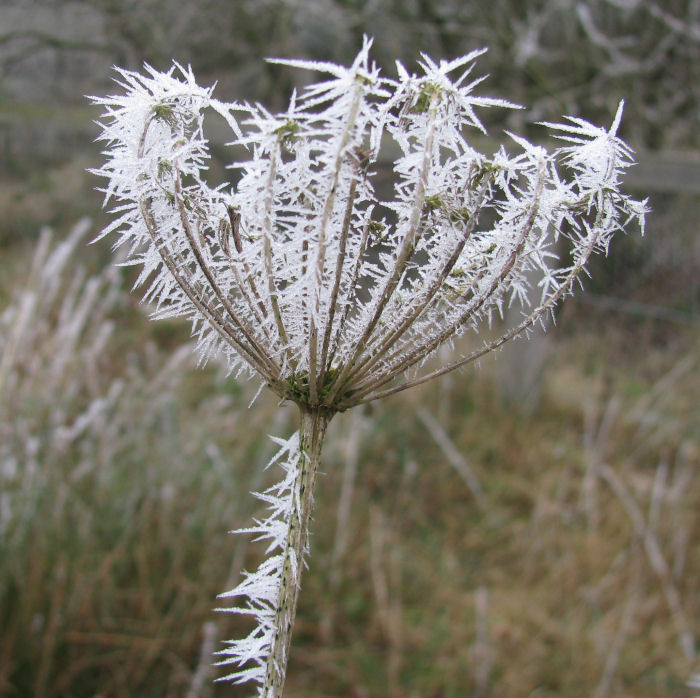
As was the Gorse on the moor.
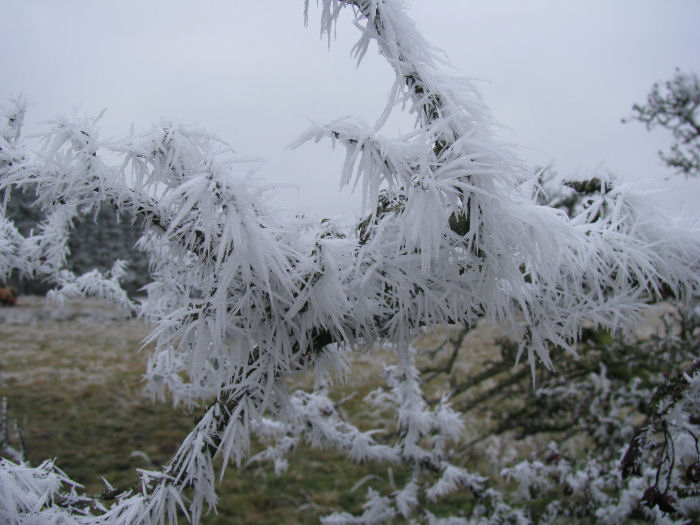
The Highlanders were on the moor at this time and we took them some food. I seem to recollect that I was sent through the gate to feed them, with a bucket in my hand, full of cattle cake. They seemed to know the bucket and came rather quickly. I spread the cake and made a very hasty retreat! It was not often that we could photograph all four together, but food made the difference.
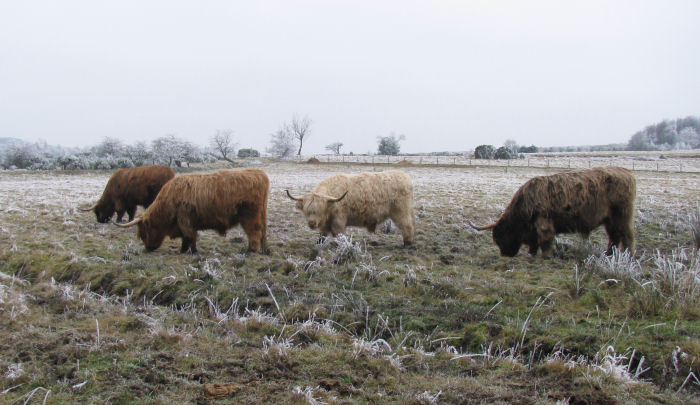
Our walk took in the newly completed wetland. It has changed since its creation.
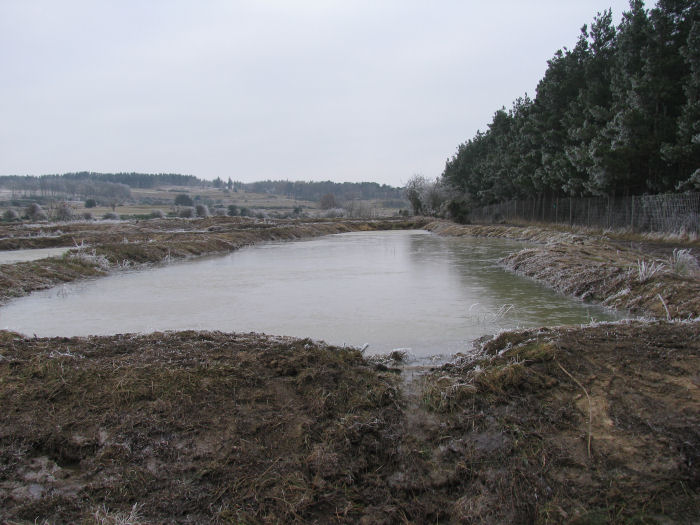
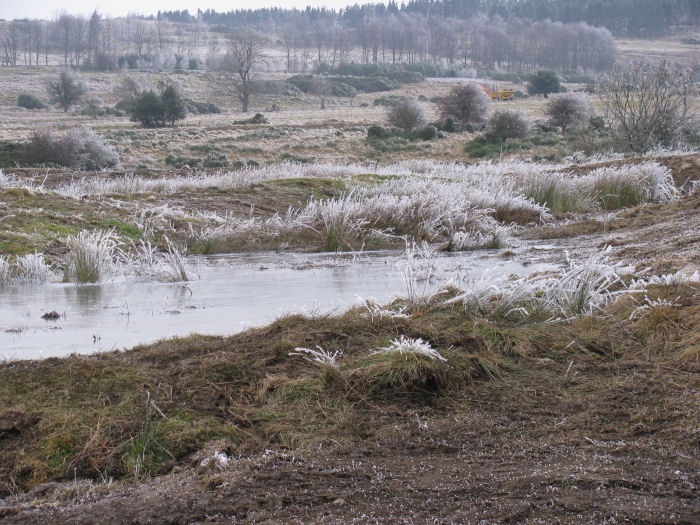
However some things on the reserve do not change. Yesterday a tree had fallen over the tank tracks and armed with a saw with a new blade, Sandra, Brian and Sophie made it safe - thank you.
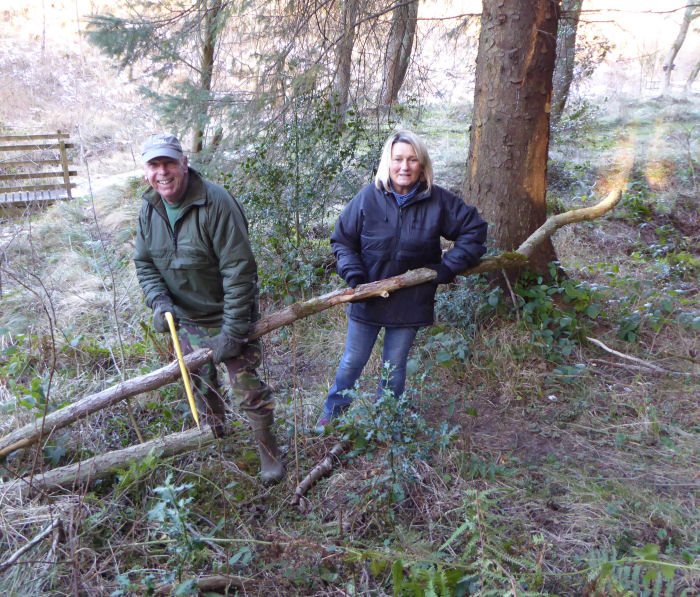
Not Quite as White
Saturday, January 14th 2017
The snow was still lying in places around Foxglove this morning.

It looked quite pretty sitting in the hollows.

But it was not as white as Signy! Stacey wrote these notes to compliment the photographs she sent. 'We have had some nice icebergs. I quite like this one as it is unusually square.

Because they are so big, they get partially grounded around the island. These then move slightly with the tides and strong winds, and either slowly break down, filling the bays with small chunks of ice or slowly drift away to be replaced by others, which gives us an ever changing view to look at.'

Her penguins are doing well. 'The adelie chicks are getting quite large now. They are big enough to not be eaten by the predatory skuas. Many are no longer being guarded by their parents, although the two in the photograph are still being guarded, and instead the juveniles creche together for warmth and protection, which enables both parents to spend their days out fishing, returning in the evenings to feed them. The chinstraps are busy hatching.'

The bird ringers also had a black and white bird visit the ringing room, a tad smaller than the chicks above! A Coal Tit. It was hatched in 2010 so is coming up to seven year old and was showing its age a little, being quite grey.

Not many nets were raised but nearly 100 birds were processed. Species ranged from Blackbirds to yet more Blue Tits, Siskin, Redpoll and Robin. More Bullfinches are making an appearance.

One species we did not catch was the Crossbills, seen feeding near the outdoor classroom.
Many thanks to everyone who helped today, and Stacey for her photos. It was cold but the snow did thaw a little on the moor and by mid-afternoon it was almost green again.

A Flurry of Snow and Activity
Friday, January 13th 2017
The drive up the track this morning was …… interesting. The thin layer of snow had me wishing that my little van was a 4 x 4. The only tracks before me were Roe Deer,
The wind overnight had us concerned that there may be the odd tree/branch down, so the first job was to walk the conifer perimeter to see if any had been wind blown.
The snow on the tree trunks indicated that the snow had been blown in from the West, and ....
...it was slowly decreasing as the morning went on. Views of the reserve were spectacular as I made my way around ticking off various jobs like checking the Exmoor Ponies.
and the motion sensor camera on Risedale Beck, the snow hiding any otter spraints.
A quick look at the Wetland Bank, which, even if I say so myself, looks excellent. All our efforts certainly appear to have paid off.
Thank you to Peter for his consistent hard effort today…. he will sleep well tonight!
Coppicing and Birds
Thursday, January 12th 2017
As we’re at risk of sounding repetitive there won’t be much said about today’s main task of continuing the coppice block, but a big thank you to all who helped with this and other jobs around the reserve.


We got lots more done and Jonathan also tried out the new forestry helmet he got for Christmas!

Unfortunately all the noise in the coppice block just behind the garden meant that the feeders out there were a bit quiet today, much to the disappointment of some bird-watching visitors. Until, that is I suggested looking to the feeders outside the kitchen… To avoid the noise and activity the birds were simply using the feeders on the other side of the building!
The aforementioned visitors said they saw all they had hoped to see in just the few minutes I was with them, and one of our volunteers said she saw 10 species out there at once! I can believe it! Today, just by those feeders, off the top of my head I remember seeing: blackbird, robin, blue tit, great tit, coal tit, marsh tit, brambling, chaffinch, redpoll, siskin, long-tailed tit, reed bunting, nuthatch and goldfinch!




If you like birds why not come and see how many species you can spot on our feeders or book a place on our Bird Song Breakfast –a chance to enjoy our beautiful reserve and its unique setting at a time when few folk see it. There will be a guided walk around the reserve led by Tony Crease and others, to see which birds can be heard singing as they wake to greet the dawn, followed by a drive through the Military Training Area to look for black grouse. The climax will be finishing with a fat boy’s breakfast at Wathgill. It’s not happening until May, but there’s no harm in getting your bookings in early!
Lichens and Nest Boxes
Wednesday, January 11th 2017
The bitter windy day began with the checking of the moth trap. The trap itself did not yield any moths, but the white sheet which reflected the light of the bright mercury vapour bulb had just one Early Moth sitting on it.
Our knowledge of Lichens is very limited, so we were more than happy to join a group who attended the reserve with the sole purpose of identifying these much by-passed mini wonders. With lens in hand I was introduced to a beautiful micro world with words like Thallus, Crustose, Foliose and Fruticose that had my head spinning. We examined stones, this one with a beautiful Baeomyces rufus

The lens showed us its mushroom like fruiting bodies. Some lichens are only found on certain rock types, and you could identify a rock by the identification of the lichen.
We made our way around the reserve from bridge handrails showing Physcia aipolia...
...to rotting wood with a variety of Dog Lichen; a sample has been taken away for a detailed examination.
And examining branches with Physcia adscendens
As well as bark crevices hosting a multitude of lichens
Thank you to Lez and Sue who are also Lichen recorders for the Catterick Training Area Conservation Group, as well as Chris Meek who set up and led this walk.
In the afternoon we ventured out into chilly blustery conditions to clean out some owl boxes ready for potential inhabitants later in the spring.
With some of the boxes occupied by Jackdaws last year there was a fair bit of twigs and debris to remove.
Replacing some boxes we discovered Larch Ladybirds, and other delights, as yet I am unable to identify the orange beetle in the middle of the pic below
This bat box had a wasp nest filling the entire box, thankfully it held no wasps with only queen wasps over-wintering elsewhere.
And Still the Coppicing Continues…
Tuesday, January 10th 2017
Our Tuesday volunteers continued this year’s coppice block today as the main task, with help from the Dales School who were back at Foxglove after the Christmas holidays.
Coppicing involves repeatedly felling the same stump near to the ground and then allowing shoots to re-grow. This maintains trees at a juvenile stage and creates woodland with multi-stemmed trees. Along boundaries and net rides we sometime pollard trees instead. This involves removal of the upper branches of a tree nearly back to the trunk, promoting a dense head of new growth. Pollards are a traditional method of marking boundaries. Although it can initially look quite bare: Once an area has been cut, the soil is warmed by the additional light reaching the ground and there is an explosion of plant life as the seed bank is stimulated.
The Willow Carr running through the centre of the reserve is managed on a ten year coppice rotation. The area is split into five blocks, one of which is cut every second year. This creates a habitat mosaic with a variety of stages of growth, so lots of niches for our wildlife! This year’s block is close to the car park and the Field Centre.
We also leave some trees as standards, but these needed thinning so as not to produce too much shade, which could stunt the regeneration of the coppice stools. This is a job to do carefully, making sure to look regularly at the bigger picture, so any trees to go were marked up in fluorescent pink spray paint to avoid any confusion.
Semi-useful fact of the day: fluorescent pink spray paint is not easy to see if you’re red/green colour blind!
Meanwhile, back at the Field Centre Ann, Ann and Bob were tidying up the garden. Clemie looked like she wanted to help too!
The Job List Grows
Monday, January 9th 2017
With the weekend Worky Day over today was a day of looking over what we had done and to assess the next stage of action. The work we had completed had been carried out with fantastic results, it was now a matter of finishing off, and tidying up after ourselves. I also had the chainsaws to strip down and service so had to pop down and buy a few new parts to keep them in decent working order.
The major job of the day was to walk the Green Route to assess any path repairs, or any other job needing attention. Armed with pen and paper we ventured out noting any hazard, or issue, as well as trying to spot signs of nature rearing its head. Jennifer could not resist having a look inside the Ash with its natural arch above Risedale Beck.
There are some really interesting, old gnarled trees at Foxglove: Another Ash tree that had split and collapsed, then sprouted again was a garden of mosses and fully leafed Wood Sorrel, conifers had even started to grow on it - still only 2 inches high.
On the Moorland the Exmoor ponies were looking healthy, the mare called Sky pawed at the gorse to remove spines before munching away.
Small yellow Gorse flowers are starting to show, and give it a couple of weeks the Moorland will be a show of yellow. This is a prolific plant, with a multitude of seed, and as you can imagine we are not short of it, to the extent of having to control its growth from taking over the heather.
Frosty
Sunday, January 8th 2017
The weather was very local today. Some bird ringers travelled through light mist and sunshine whilst others braved fog and freezing temperatures. Foxglove started frosty but soon warmed a little. Bramble leaves close to the ground were covered in frost.
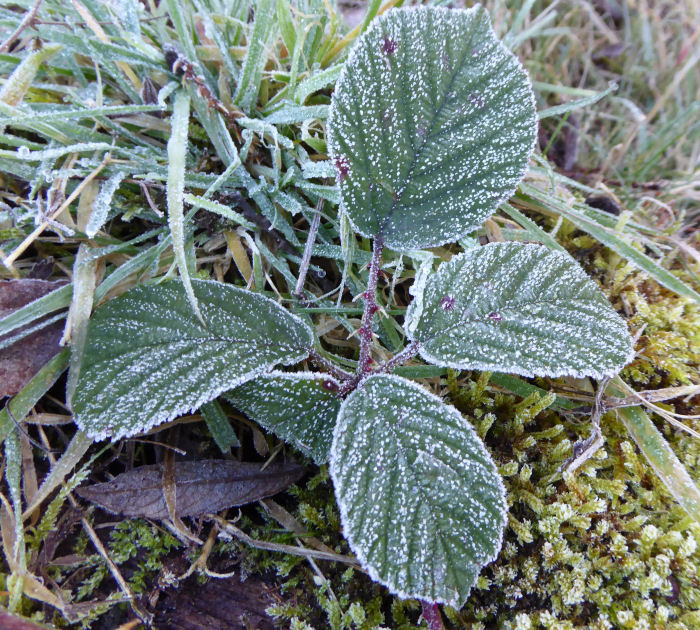
Moss on the logs and stones was also caught.
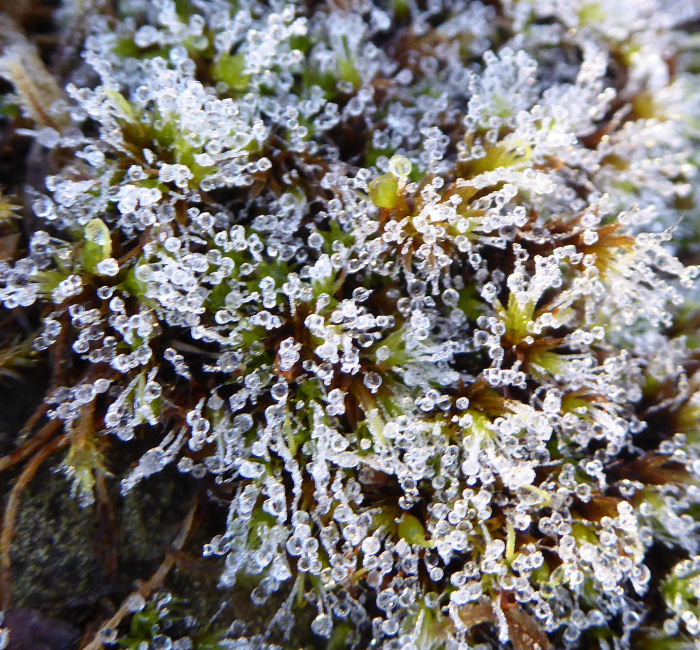
Although there does not seem to be much stirring, under the right light conditions the odd spider web can be caught. I wonder where the spider is and what it eats?
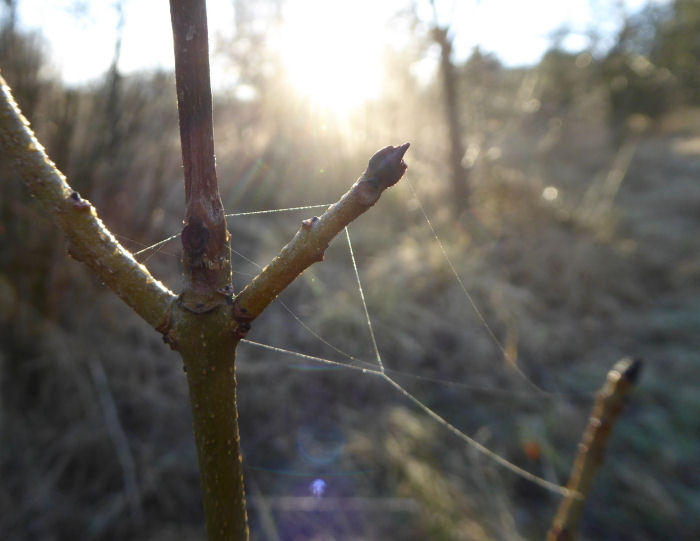
It was cold overnight so it was a little surprising that there were four Early Moths on the walls of the Field Centre. It is not the best background for phtotgraphs but we did not want to disturb the moths. The larvae feed on Blackthorn and Hawthorn, of which there is plenty on the reserve.
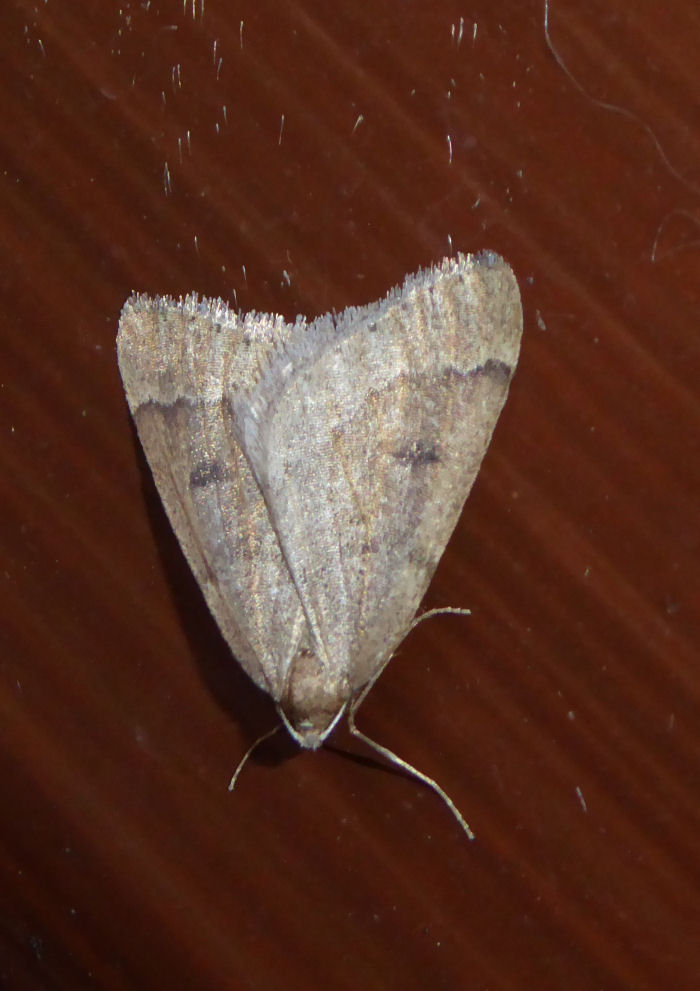
The lake was still and the reflections almost perfect. Hope this is the right way up!
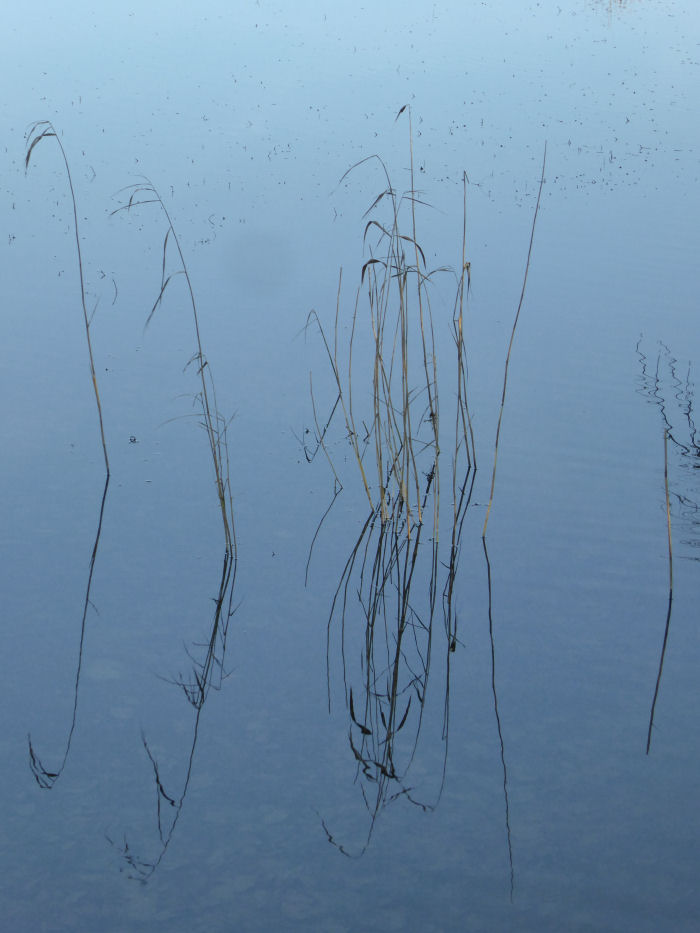
It was a late start for the bird ringers and an early finish as some had already had a busy day previously, on the Worky Day. Not many nets were raised but 44 birds received their rings. This total included 11 Redpoll, 8 Greenfinch and 6 more Blue Tits! One reason for ringing today was to try to catch some of the numerous Brambling that have been seen in the back garden. Unfortunately they were obviously feeding elsewhere as only 4 were caught. Amongst the 50 retrapped birds, was a Great Tit ringed in the next box, in 2010.
Thank you to everyone who helped today. Sausage rolls were well received as were the numerous cups of tea.
Coppicing Continues
Saturday, January 7th 2017
Despite an ominous weather forecast and looming grey skies, today’s Winter Worky Day passed without a drop of rain! Today’s main task was coppicing and we had three parties working simultaneously in different locations. Two sites near the workshop and car park:


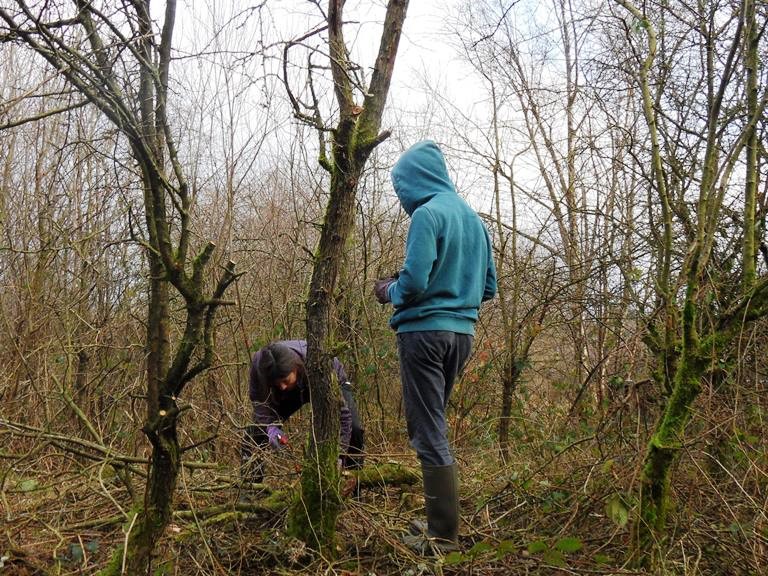
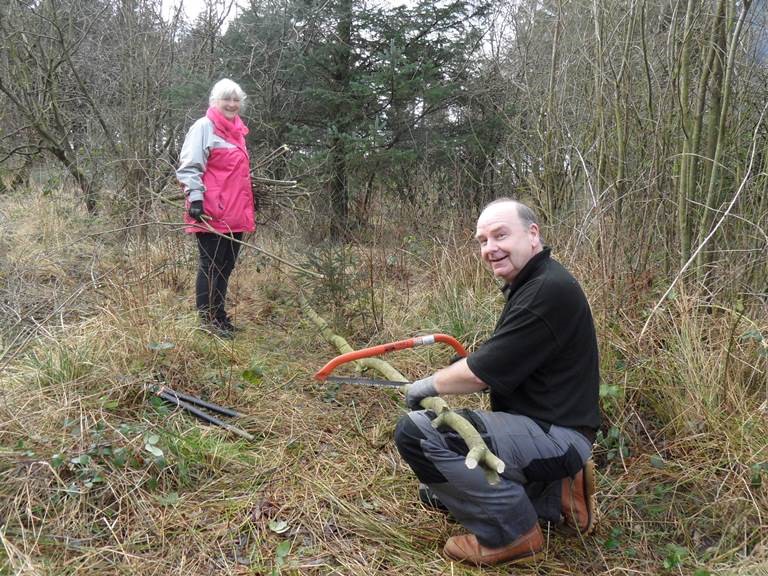
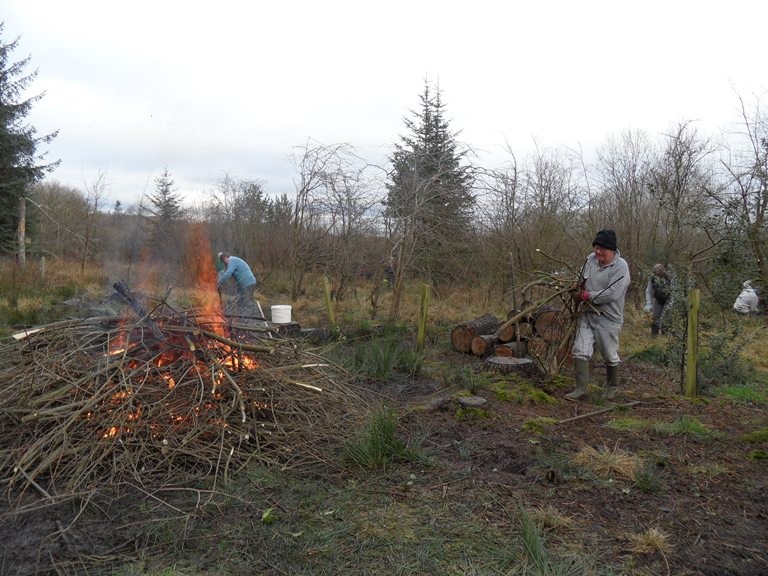


And a further site on the way to the lake:
.jpg)
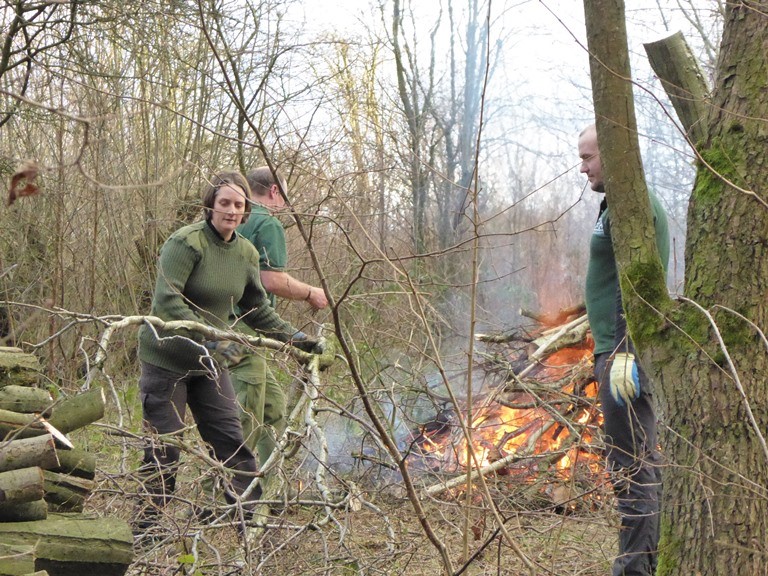
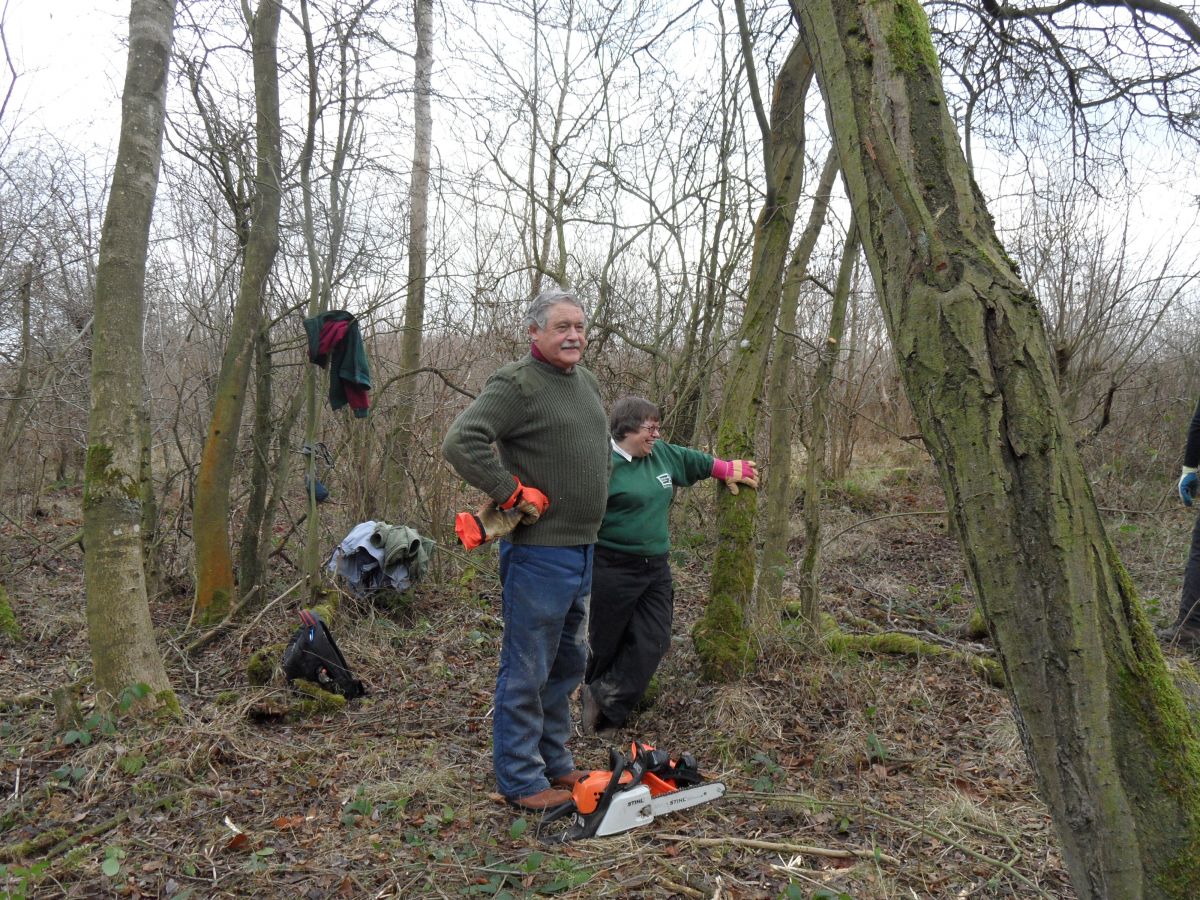
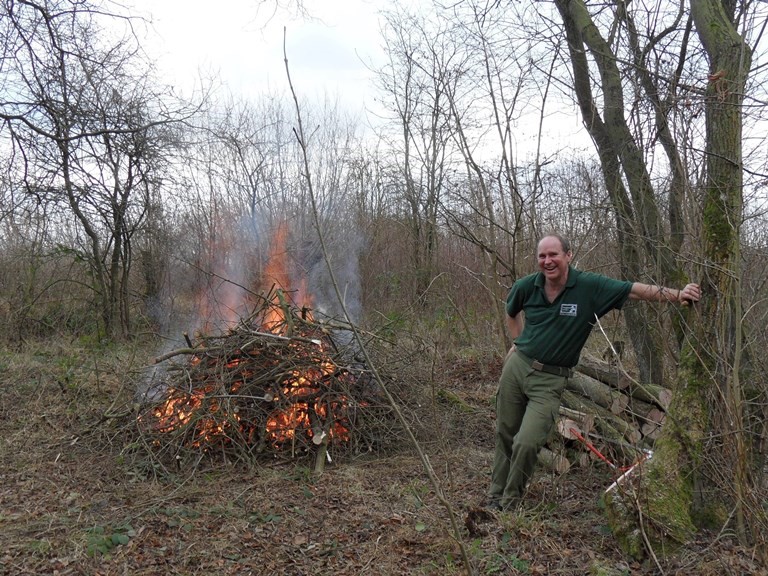
Young and not quite so young worked together, accomplishing a great deal.

Meanwhile Peter and Irene (and Peter) spent the morning thinning the dense Sitka Spruce (and a little of the Scots Pine) which had regenerated in a previously felled area of the conifer plantation.
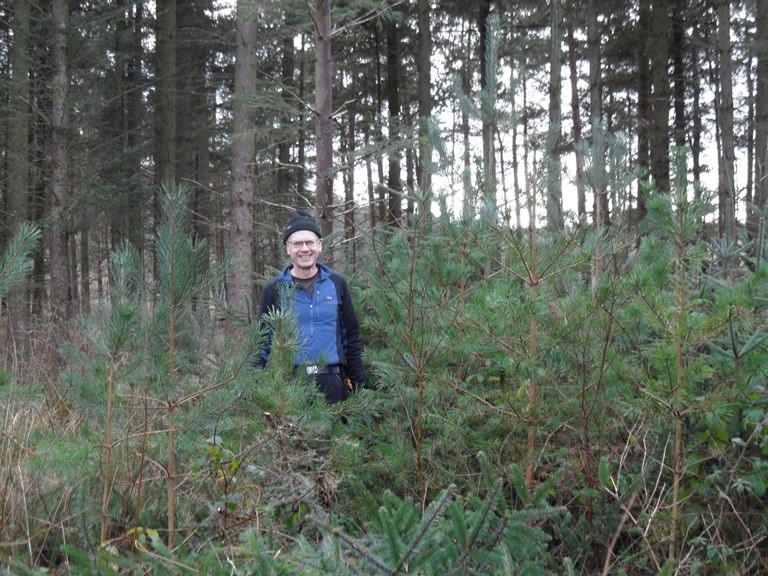

Bob also performed the indispensable task of weighing out bird seed ready for sale in the field centre.
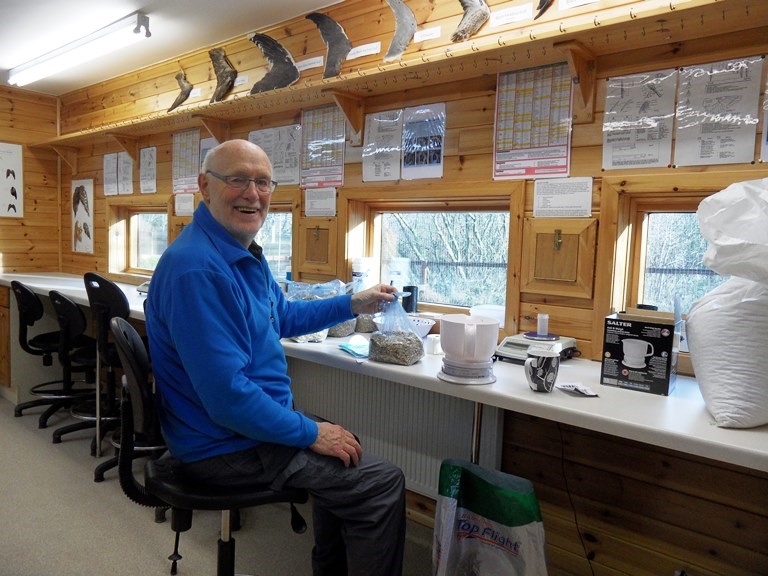
We were all fuelled through the day by the usual delicious curry and some rather excellent cake.
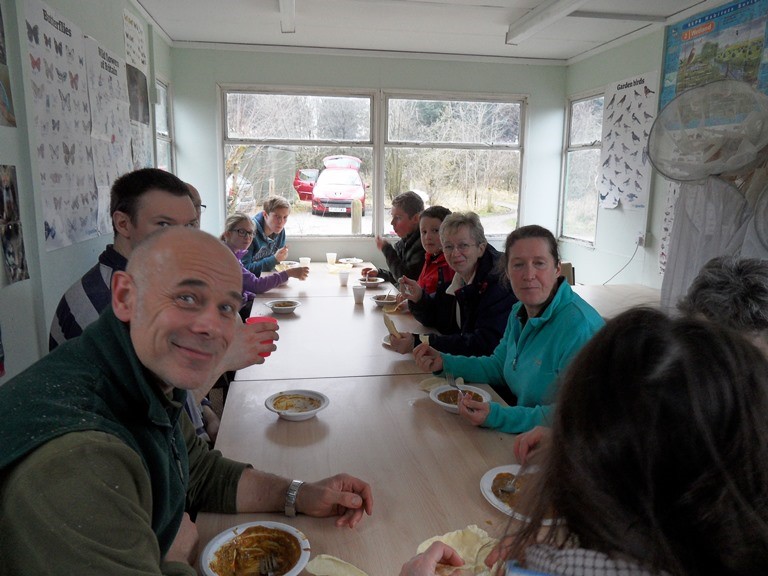
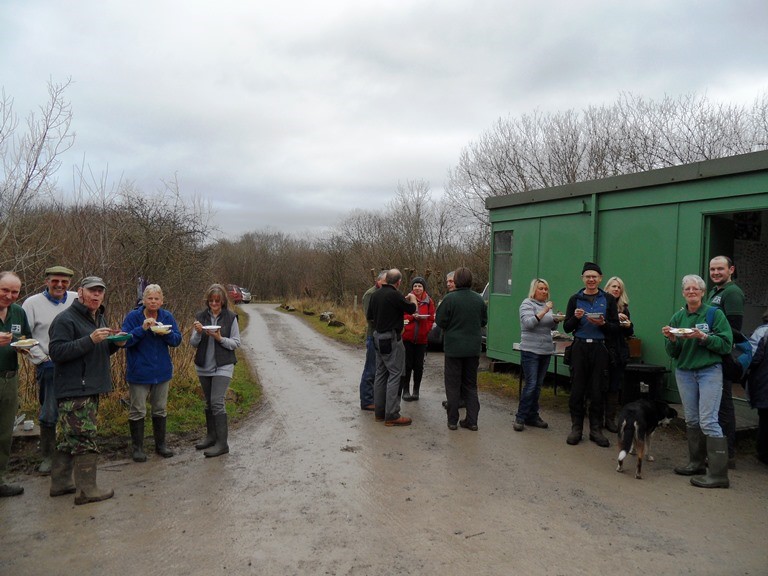
Thank you to all who helped in whatever form.
This was a guest blog by Peter B.
Undoing Work
Friday, January 6th 2017
Our main activities today were not particularly photogenic, as we were finishing off a report and preparing for the January Winter Worky Day tomorrow. However, we did spot a feeder full of long-tailed tits – and they ARE photogenic! I can see eleven in the picture, one with a ring visible. Perhaps some of them are the ones our licensed bird ringers put rings on back in December? Without reading their ring numbers we can’t be sure, but we do know that long-tailed tits are very social. They stay in their family groups over winter and huddle up together at night for warmth, so it’s not unlikely that they are wearing rings from the same string!
A thank you to Colin who helped us today by filling the bird feeders – he was the first to spot the long-tailed tits - and carefully tidied up the unsightly mole hills in the Field Centre garden (the reflection on the window doesn’t benefit the photo sadly).
As we ate lunch I caught movement in the corner of my eye. A new molehill appearing! But I didn’t get outside quickly enough to see the mole…
We couldn’t quite decide if Colin had been undoing its work or it his! Possibly both..
Jobs Completed
Thursday, January 5th 2017
There was a heavy frost and a chill which was with us for the whole day. What was good was the blue sky and the low winter sun warming to the soul. Being Thursday Volunteer Day we had a small but determined group of folk who just got on with the various jobs of the day. Tony Cooper was in the Field Centre doing the monthly stock check; Mike was monitoring water levels around the reserve, while the rest of us finished off tidying the brash from yesterday’s final push on the Wetland Bank.
There is a lot of work that goes into what may sound like a simple quick job, but the effort and time spent by our Tuesday and Thursday volunteers is astonishing. The results speak for themselves with sunlight gracing the bank unshaded by the overgrown Hazel, and a rotting fallen willow.
Jackie can be seen seen in the foreground, by Risedale Beck, where the team cleared brash from yesterday’s efforts. Just adjacent to this spot I noticed an Otter spraint site. You can see the various ages of these spraints which are territorial latrine markers, black being the fresher. Some of the content was interesting as I could see mammal bones amongst the fish bones.
Primroses peeking through on the now sun drenched Bank.
With the Bank finished in the morning the afternoon was dominated by the path that leads to the net ride behind the Field Centre. I have wanted to do this path for some time as it gets constantly poached with foot fall.The logs are placed to form the path edging, secured by hazel stakes.
We used recently cut wood from the Bank, not Willow as it readily takes root and regrows, not the ideal for a path! This forms a foundation structure to prevent the wood chips going to mush with the wet ground.
The cutting of the numerous lengths was a laborious task but the results were fantastic.
Dusk soon turned to night as we put the final touches of chippings onto the path timber foundation.
Thank you to the whole team today for such fantastic work which went into the dark but got the job finished.
Spot the Pinecone!
Wednesday, January 4th 2017
Today was a day of odds and ends, with, among other things, trying to track down photos to confirm some of our moth records…
…continuing the clear-up of the coppicing on the south-facing bank down to Risedale Beck from the wetland…
…and showing a proud new adopter of one of our bird boxes his box!
We still have some boxes without sponsors for this nesting season (cue sad faces and ‘awww’ sounds), so if you fancy adopting one of these please check out our website or speak to a reserve manager. By sponsoring one of our boxes you will be helping to fund our conservation work, improving habitats for many species. We monitor the use of our habitat boxes and as a sponsor of one you receive an annual report in the autumn of who’s been using them!
In other news; I’m certainly feeling like I’ve done well for food over the festive season, but our wildlife doesn’t have it so easy. To stay alive over the winter they adopt a range of strategies (depending on species) including hibernation, migration, defending territories or caching food. We found someone’s food cache today high in a hazel tree – spot the pinecone!
As we came in for the evening we were treated to this lovely view of the moon over the trees.
Have a lovely day and we hope to see you here at Foxglove soon!
Starling Murmuration
Tuesday, January 3rd 2017
Winter is a busy period for the bird ringers and during the Christmas break the Foxglove Ringing Team have been making the most of local opportunities to catch different species of birds (with varying success). Some of the team were out on Monday evening at a nearby Starling roost and worked hard during the afternoon to set up 3 nets in a reed bed. The site was known to be used by around 4,000 Starlings as an overnight roost and the murmuration was discovered last week. Roger kindly carried out the required 'depth test' to see just how deep the water in the reed bed was! Having decided that it was not too deep the team set to and prepared 3 net rides. They then put out the nets and watched as thousands of birds appeared to fall out of the sky over a period of around 15 minutes.
The catch, although purposely restricted, was a success,and resulted in 75 Starlings and 2 Wrens being caught in the specially designed mist nets. The birds were taken back to the nearest ringer's garage and were carefully fitted with a BTO ring. Biometrics taken included age, sex, wing length and weight. This information will be valuable to the BTO as these are now relatively scarce birds. The large flocks are deceptive as Starlings are a species in serious decline and now on the red list for conservation.
Up close they are stunning birds with purple and green metallic plumage. This one is a female and has an indicative pale ring around the iris of its eye.
After several hours of extracting and processing the birds the ringers enjoyed a hot mince pie! It was like a senior citizens' away day!
The birds were roosted overnight in a shed and released this morning at dawn. They all flew away to feed in the local fields and gardens and several have been sighted feeding on fat balls in the area where they were released (close to the reed bed).
A New Year Starts
Tuesday, January 3rd 2017
Happy New Year from us both and we hope you had a great Christmas.
This was our first day back after the New Year and we hit the ground running so had little time as Reserve Managers to chat about the day's jobs. As it was we had priority jobs that had been wanting from last year…. The Wetland Bank.
This area had a fair bit of work carried out on it in December. The Hazel coppice was over grown and had started to collapse due to the heart of the timber rotting, and the weight of the top growth. Some of these Hazel stools are over 50 years old so it is all the more important to keep them coppiced and well managed.
With all the timber felled we have loads of brushwood to deal with and the fairly hefty logs to carry back to the workshop, some of which will form edgings to paths.
The wind over the holiday period had also taken its toll on one of the Hawthorns.
Due to the fragile state of the fairly steep bank, as well as preserving the various flora and fauna which is starting to emerge, we converted the brushwood that had been cleared late last year and got the chill of the wind blowing in off the moor cancelled out by the warmth of the fire and the warmth of hard work!
Back at the Field Centre the Christmas decorations were being taken down,
and Ann double checked the bird bags from yesterday’s bird ringing of Starlings.
It is important to know how many bird bags we have so no bird is extracted from a mist net and accidentally dropped when in a bag. This way we are able to check bags in at the end of a ringing session and if a bag is missing we have to find it.
Thank you to the whole team and also to John and Eddie who beavered away, separate from the main group, repairing bridges and dealing with tree guards. They succeeded in avoiding me with the camera!
Birds Overtake Views
Monday, January 2nd 2017
This morning the idea for the blog was to show some views of Foxglove. Firstly, the reeds which at this time of year look grey and fluffy given the right light conditions. Volunteers walking through the reed bed heard the call of Reed Buntings.

The next view was of the wetland, looking beautiful, with blue skies and frozen ponds.

But then birds took over. One Fieldfare was spotted on the middle moor and the camera was pushed to its limit to catch this image.

From the window in the Field Centre a Blackbird was observed eating some Guelder Rose berries. Of course by the time the camera was found and ready it had stopped eating them. By the beginning of spring Guelder Rose shrubs still have all their berries! May be not this year?

Blue Tits are small birds seen flitting amongst the trees and are often seen on the back garden feeders. During the year 348 adults and 185 nestlings were ringed. They don't often get their photo on the blog, but this one co-operated!

Great Tits are another visitor to the back garden feeders. This one also sat still long enough for its photo to be taken, without too many branches in the way.
.jpg)
Blue Skies - Thoughts of Summer
Sunday, January 1st 2017
If you did not open the doors or look at the swaying trees and focused on the blue skies you could have thought that summer was here - it would take a bit, well a lot of imagination!
I love taking raindrops on things and this Greater Spearwort shows off its bright yellow petals and its covering of rain drops.

Dog Daisies, with their flat heads are ideal to catch the rain.

Unfortunately Cotton Grass does not react to rain very well and looks very sorry for itself when wet. But its stems have proved an ideal place for a spider to attach its web.

When it is dry it is as we expect it to be, fluffy!

Some insects disappear when it is wet, others try to hide, but don't quite manage to escape.



.JPG)
(1).JPG)

.JPG)







.JPG)
(2).JPG)
.JPG)
.JPG)
.JPG)

.JPG)
.JPG)
.JPG)
.JPG)
.JPG)
.JPG)




.JPG)
.JPG)



.JPG)
.JPG)
.JPG)




.JPG)





.JPG)

















































